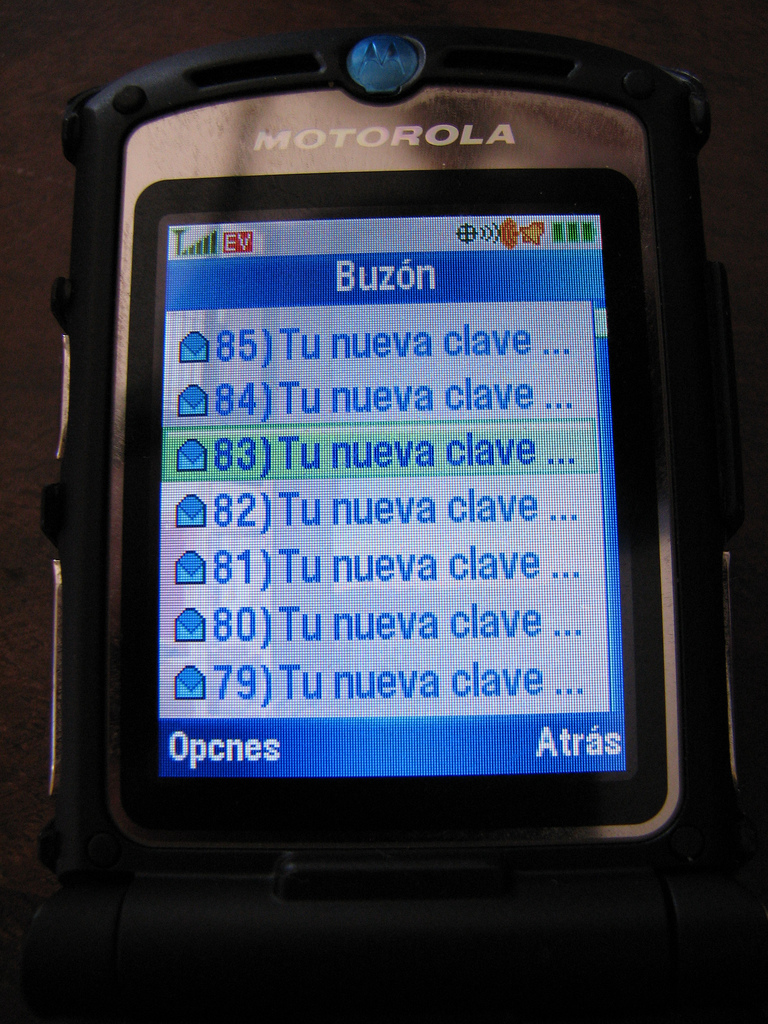Mobile Music South of the Border
Patrick Burkart and Christopher Joseph Westgate / Texas A&M

This piece is related to a longer project: Burkart, P., and Westgate, C.J. (forthcoming). Mexican Mobile Music: Una convergencia con sabor. In Oxford Handbook to Mobile Music and Sound Studies. Eds. Sumanth Gopinath and Jason Stanyek. New York: Oxford University Press.
Introduction
In the spirit of Flow contributors Aslinger((Aslinger, B. (2008, November 13). The Sounds and the Business of Mobile Music. FlowTV.org. http://flowjournal.org/?p=2151)) and Crow((Crow, B. (2008, September 4). Mobility, spectrum, and television. FlowTV.org. http://flowjournal.org/?p=1740)), we continue the investigation of media and mobility. This article explores the media economics of the mobile music market in the context of a country whose cultures, economics, and politics have been continually expressed in mobility and in music. Mexico has countless local and regional musical traditions, a healthy domestic music industry, and strong cross-border, intercultural appeals. These traits support the growth of end-to-end mobile music services that could result in new social networks oriented toward sharing or consuming Mexican and Latin music on cell phones.
We conceive of this article as an exploration of the “Celestial Jukebox,” a metaphor for the evolution of pay-per or subscription-based entertainment services that are copy-protected, personalized, and media-conglomerate owned and licensed.((Burkart, P., and McCourt, T. (2006). Digital Music Wars: Ownership and Control of the Celestial Jukebox. Lanham: Rowman & Littlefield.)) Its extension to developing countries moves from the music industry’s networks to an economically peripheral region of consumers. It does so wirelessly, and opens many new channels for personalized delivery content, alongside the existing ones established on hard-wired multimedia computers and their peripherals. Here, we briefly survey the revenue models, market structure and content-carriage partnerships in the emerging Mexican mobile music industry.

Revenue Models
The CD market still dwarfs the total digital (online and mobile) music markets with a 90 percent share across all formats.((IFPI [International Federation of the Phonographic Industry]. 2007. The Recording Industry In Numbers, p. 10.)) Yet, mobile music sales almost doubled in 2006 to U.S. $1 billion worldwide.((This essay deals primarily with mobile music downloads taken from wireless telephone networks. Mobile music streaming and downloading (as opposed to “sideloading” with physical cables or memory chips, or preloading music on a handset at the factory) provide an on-demand, always-on, end-to-end telecommunications service.)) Mexican mobile digital sales rose from $U.S. 1 million to $8 million between 2005 and 2006.((Ibid.) Across the region, digital’s share of the Latin music market generated 12 percent for the first half of 2008, and most of that share was mobile.((Cobo, L. and Ben-Yehuda, A. and Waddell, R. (2008, December 20). Latin America: In with the New. Billboard, p. 41.)) Pay-per use download and subscription services are the most common revenue models for digital music distribution. Pricing strategies for various formats are still experimental, and seem to be driven by carriers, rather than record companies. In general, ringmaster downloads prove more profitable than ringtones for record labels and music publishers alike.
Mobile music on cell phones also introduces hardware-software synergies and opportunities for strategic partnerships. For example, handset maker Sony-Ericsson has a stake in mobile music licensing and has allied with carrier Telcel, while LG has released handsets running the Microsoft mobile operating system for the Movistar network. Finally, leasing access to facilities, rather than purchasing and operating them, presents some competitive advantages for experimental business models.

Market Structure
All four carriers, Telcel (América Móvil), Movistar (Telefónica), Nextel, and Iusacell, supply ringtone downloads. In 2007, Telcel dominated the voice market with a 74 percent share; Movistar was second with 16.5 percent, and Iusacell Unefón followed with 6.3 percent. Nextel took 3 percent. Azteca, which owns 77 percent of Iusacell, is the only fully integrated (content-carriage) media producer with a wireless VAS network for mobile music distribution in Mexico.((Globalcomms (2009). Telegeography Database. Accessed 2/18/09.)) The merger between Iusacell and Unefón in 2007 reduced the number of national carriers by twenty-five percent, further consolidating the infrastructure layer. Azteca is the primary national competitor to Televisa, the parent company of the dominant TV and cable networks. Azteca is also the parent company of Iusacell. All four carriers rent their infrastructure to third party providers of telephone service and broadband.((Ramos Mateos, J. L. (2007). Tecnologías Digitales y Telecomunicaciones. In F.G. Luna Bueno, G.S. Gutiérrez and J. Tejado Dondé (eds.), La Regulación de las Telecomunicaciones. México: Miguel Ángel Porrúa.))
The carriers are making the first moves in the market for mobile music services, and the content providers are releasing their catalogs slowly and selectively. Vivendi-Universal, Sony-BMG, EMI, and Warner (the “big four”) have partnered with firms that specialize in building and bundling recorded repertoires. Televisa’s Esmas Móvil is Mexico’s flagship mobile content portal for cell phones.((De La Fuente, A.M. (2008, October 20). Televisa, Telemundo Pact on Content. Variety. Accessed 2/18/09.)) The company’s “Ideas Music Store” features a catalog of more than 200 million multi-genre songs from all four major labels. In competition with Telcel, Telefónica’s Movistar Música began selling full tracks from the majors in 2008.((Latin American Music Business Charts New Territory. (2008, December 13). Javno. http://www.javno.com/en-bestseller/latin-american-music-business-charts-new-territory_214325)) Nokia opened its digital music portal in 2009, in partnership with Sony-BMG, Universal, Warner and EMI.

The Mexican Music Industry
A hybrid class of carrier-content operators has yet to emerge in Mexico or in the U.S., despite factors that might encourage it.((In both Mexico and the U.S., the branded mobile music services have resembled the earliest “music service provider” stage of the paid download market (see Burkart and McCourt. However, it is the wireless carriers, and not the labels, that have created the new market.)) These factors involve the cross-over appeals of Mexican music, the formal competitiveness of the telecom services sector, and deregulated markets for virtual mobile network operators and others providing music and media as paid services.
Mobile music catalogs have so far drawn from a repertoire of national performers, at least in part. The “big four” have a presence in Mexico directly and indirectly through major partnerships. In 2005, Sony Mexico took 20 percent of the market share, followed by Warner (15 percent), Universal (14.5 percent), BMG (12.5 percent), EMI (12 percent), and Fonovisa (6 percent).((Mejia Guerrero, A. (2008, February 22). Nokia Busca Avanzar en Mercado de Internet Móvil: Nokia Va por el Mercado de la Red a Nivel Personal. El Universal.)) Televisa-EMI has participated in the development of Mexican mobile music with Tarabú. EMI has developed a catalog of artists in the pop and regional Mexican meta-genres, such as Bebe, Intocable, and others. Universal Univisión’s musicians span pop, regional Mexican, tropical and rhythmic genres, including Juanes, Enrique Iglesias, and others. Although Mexico has witnessed a boom in new artist signings, the country’s music industry has also lost its place among the top ten global music markets because of economic conditions and “piracy.”
Conclusion
Mobile music could be a strategic sector for export promotion. Mexico’s resurgent film industry, and high-value television programming, position the music market favorably for mobile services, since Spanish language movie music and music videos tend to travel well, financially speaking.((Hanke, B. (2006). Yo Quiero Mi MTV: Making Music Television for Latin America. In A. Bennett, B. Shank, and J. Toynbee (eds.), The Popular Music Studies Reader. London: Routledge, pp. 317-325.))
Factors promoting competition in the mobile music sector involve number portability regulations, dominant carrier regulations for Telcel, an active antitrust commission, an increasing number of VAS players, the persistence of Maxcom, and the anticipated WiMAX auctions.((Telecommunications Report. (2009, March). Latin American Monitor: Mexico 26(3): 6 – 8.)) Music m-commerce may experience an initial competitive boom that succumbs to a non-competitive bust. Consolidation pressures in telecoms are increasing, and pro-competitive regulations can be stymied by appeals and other court challenges. The restrictive walled-gardens and digital rights management regimes that make a first showing already disclose that the existing potential for abusive market practices is high.
Image Credits:
1. Mobile Mexicanas
2. Cellular Statuary
3. Goodbye, Walkie Talkies
4. En Espanol
Please feel free to comment.
this was a very interesting article as one could not imagine the depth of the cellular industry in countries such as Mexico without reading this article…thank you and hope to see more by these authors…..